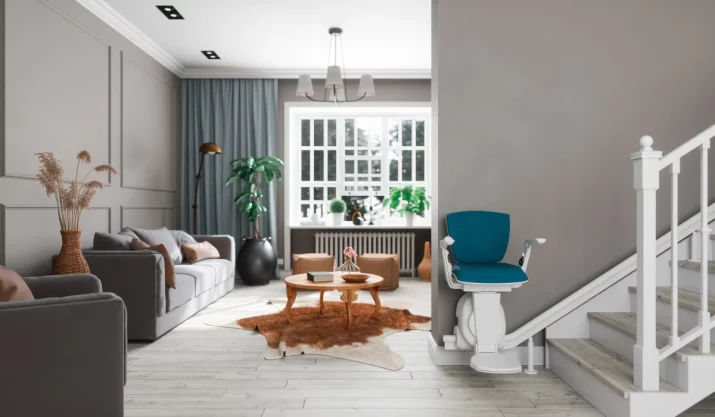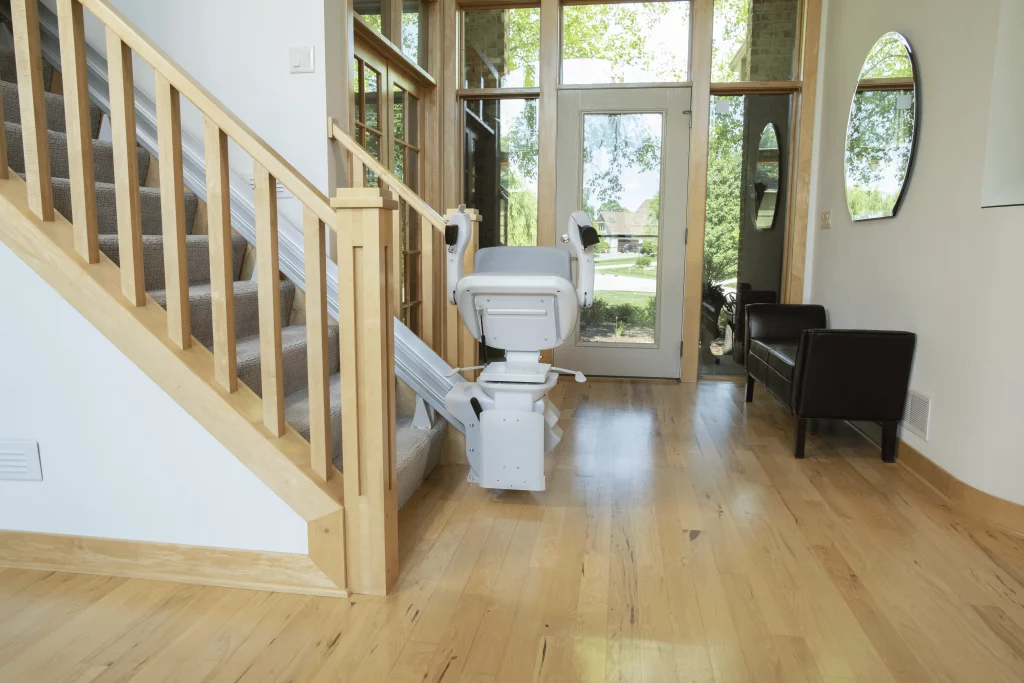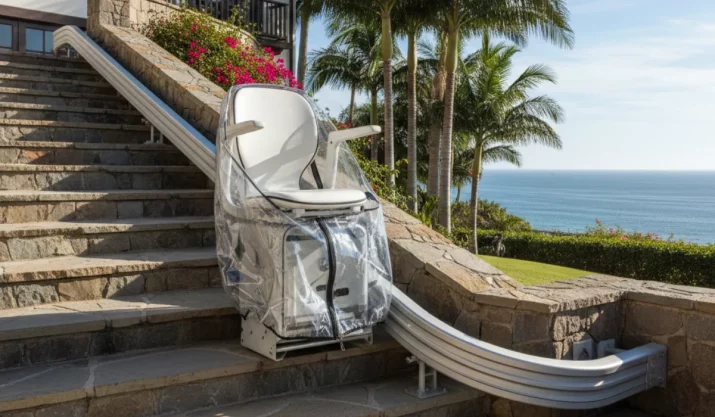How Much Space Do You Need for a Stair Lift?

Table of Contents
- Key Takeaways
- Basic Stair Lift Space Requirements
- Minimum Staircase Width for Stairlift Installation
- Straight vs. Curved Stairlifts: Which Takes Up More Room?
- How Much Landing Space Do You Need?
- Can Stairlifts Be Installed on Narrow Stairs?
- What About Outdoor Stairlifts?
- Standard Features That Help Stairlifts Fit
- Finding the Right Stairlift for Your Home
- FAQs
If you’re thinking about installing a stair lift in your home, you’re likely wondering, “Will it fit?” It’s a smart question, especially if your stairs are narrow, curved, or part of an older layout. The good news? Most homes in California can accommodate a stairlift with the proper planning and model selection.
Even if your home has unique stairs or space limitations, there are stairlift solutions designed to fit your specific needs. From compact models that fold away neatly to custom stairlift rail systems that handle sharp turns, there’s often more flexibility than you might expect.
Understanding the space needs ahead of time can save you time, money, and unnecessary home modifications.
In this article, we’ll walk you through stair lift space requirements, including the minimum staircase width, landing needs, head clearance, and how different stairlift models compare.
Key Takeaways
- Most stairlifts require at least 28 inches of stair width; however, 30 inches offers more comfort and easier use, especially for individuals with limited mobility.
- Straight stairlifts are more space-efficient and quicker to install, while curved stairlifts are custom-built for staircases with landings or turns and typically need more room.
- You need a safe landing space at the top and bottom of the stairs, usually 18–24 inches, plus at least 6 feet 6 inches of head clearance.
- Compact features, such as fold-up seats and retractable rails, help stairlifts fit into narrow or tight spaces, including outdoor installations.
Basic Stair Lift Space Requirements
Modern stairlifts are built to be compact and adaptable, but there are still a few baseline requirements your staircase needs to meet. Most standard stairlift installations need:
- At least 28 inches of staircase width
- 12–14 inches of folded chair depth
- 6 feet 6 inches of head clearance
- Enough flat space at the top and bottom of the stairs for safe entry and exit
Let’s break that down more clearly.
Minimum Staircase Width for Stairlift Installation
The width of your staircase is one of the most critical factors in determining whether a stairlift will fit your needs. Most straight stairlifts need at least 28 inches from wall to wall or handrail to handrail. However, a 30-inch staircase is more comfortable for everyday use, especially for those with limited mobility who need a bit more space to sit or stand.
If your home has narrow staircases, don’t rule out a stairlift yet. Some models are designed specifically for tight stairwells and include features like fold-up seats, armrests, and footrests that reduce the lift’s footprint when not in use.
Measure your staircase at multiple points; stair width can vary from top to bottom. Your stairlift provider will do this during a consultation, but a quick check beforehand can help you plan.
Straight vs. Curved Stairlifts: Which Takes Up More Room?
The type of staircase you have determines whether you’ll need a straight or curved stairlift. Both types come with different space requirements and installation needs.
Straight stairlifts

If your staircase runs in a single, uninterrupted line, a straight stairlift is likely all you’ll need. These are the most common and space-efficient stairlifts available.
- Minimum staircase width: 28–30 inches
- Folded depth: About 12 inches
- Rail placement: Mounts directly to stair treads
- Landing requirements: Modest space needed at the bottom of the stairs
Straight stairlifts are more affordable and quicker to install than curved models. They’re an excellent fit for many homes with straight staircases.
Curved stairlifts

If your stairs have landings, turns, or curves, you’ll need a curved stairlift. These lifts are custom-made to match your specific staircase, including curved rail sections for smooth navigation around corners.
- Minimum staircase width: 30+ inches recommended
- Folded depth: Up to 14 inches
- Rail placement: Custom rail follows the curve of your stairs
- Landing needs: More clearance is often required at turns and landings
Curved stairlifts are ideal for California homes with older architecture, split-level entries, or second-floor bedrooms that require access via winding staircases.
How Much Landing Space Do You Need?
In addition to the stairs themselves, it’s essential to have a safe, flat space at both the top and bottom of the stairs.
Bottom landing
You’ll want to ensure there’s enough room at the bottom of the stairs to safely unfold the stairlift and allow for easy transfer onto the seat. This usually means 18–24 inches of clear space beyond the last step.
Some stairlift models feature a retractable rail or hinged track, which prevents the rail from protruding into a hallway or becoming a tripping hazard.
Top landing
At the top of the stairs, you’ll also need enough space to stand and step off the chair. This flat, stable area makes it easier to exit the lift safely, especially if you’re using a walker or cane.
Head clearance
Stairlifts are designed with comfort in mind, but you still need adequate head clearance, typically at least 6 feet 6 inches from the stair tread to the ceiling.
Can Stairlifts Be Installed on Narrow Stairs?
Yes, even narrow stairs can often accommodate a stairlift. Several manufacturers, including Bruno, offer stairlift models specifically designed for tight spaces. These lifts may include:
- Slimline stairlift rail systems
- Seats that fold up when not in use
- Custom armrests and footrests to reduce obstruction
If your stairs are narrower than 28 inches, you’ll need a professional assessment to determine if installation is still possible. In some cases, minor home modifications, such as removing a second handrail or adjusting wall-mounted fixtures, can make a room appear larger.
What About Outdoor Stairlifts?
If you have outdoor stairs leading to a porch, garden, or garage, an outdoor stairlift can make those areas accessible again. These models are weather-resistant and feature similar characteristics to their indoor counterparts, including fold-up chairs and safety sensors.
Keep in mind:
- Staircase width and landing space still apply
- Installations must allow for drainage and secure rail placement
- You’ll need a nearby power source or a solar-compatible model
- Covered seating and protective covers help extend product life
Whether you live along the coast or inland, outdoor stairlifts are a great way to enjoy more of your property without worrying about falls or steep steps.
Standard Features That Help Stairlifts Fit
Stairlift technology has come a long way. Even if your home presents space challenges, many stairlift models are built with flexibility in mind:
- Fold-up footrest, seat, and armrests: Minimize obstruction when the lift isn’t in use
- Retractable or hinged rails: Clear the way at the bottom of the stairs
- Custom-fit curved rails: Designed to follow your stair shape precisely
- Multiple seat sizes and styles: Choose the best fit for comfort and clearance
- Battery backup systems: Keep your lift running during a power outage
If you’re concerned about blocking access for others or navigating a shared staircase, a well-chosen stairlift can accommodate everyone safely and securely.
Finding the Right Stairlift for Your Home
Every staircase and every household is different. That’s why choosing the right stairlift comes down to more than just measurements. Consider:
- Who will be using the lift and their mobility needs
- The type of stair lift (straight, curved, or outdoor)
- Your budget and stair lift cost expectations
- The available warranty and service support
Some families may also want to consider platform lifts, especially for wheelchair users who require a lift solution without needing to transfer to a chair. These require more space and planning, but can be life-changing in the right home.
The best way to find out what works? Schedule a free consultation with California Mobility. A local professional can evaluate your staircase, recommend stairlift models, and walk you through the installation process.






